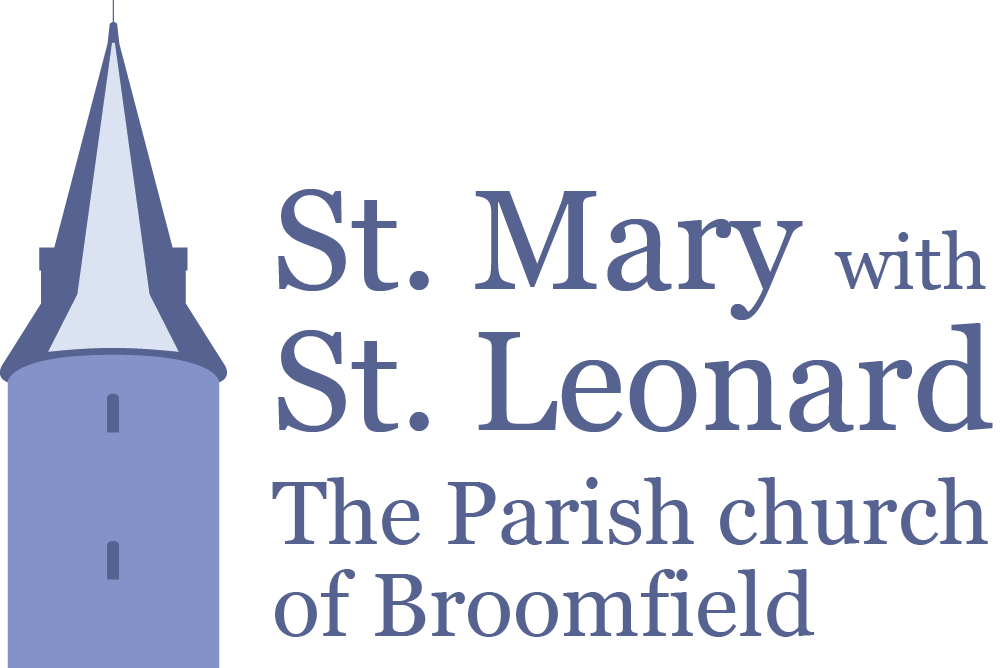The Round Tower at Broomfield, one of only six in the county, was built onto the existing Norman Church early in the 12th century. The conical roof rises to an octagonal timber spire. With its remarkable internal timber frame, this was added to the Tower in the 15th century. Some of the timbers in the spire have been tree-ring dated to between the 1470s and 1480s. The tower is hung with six bells.
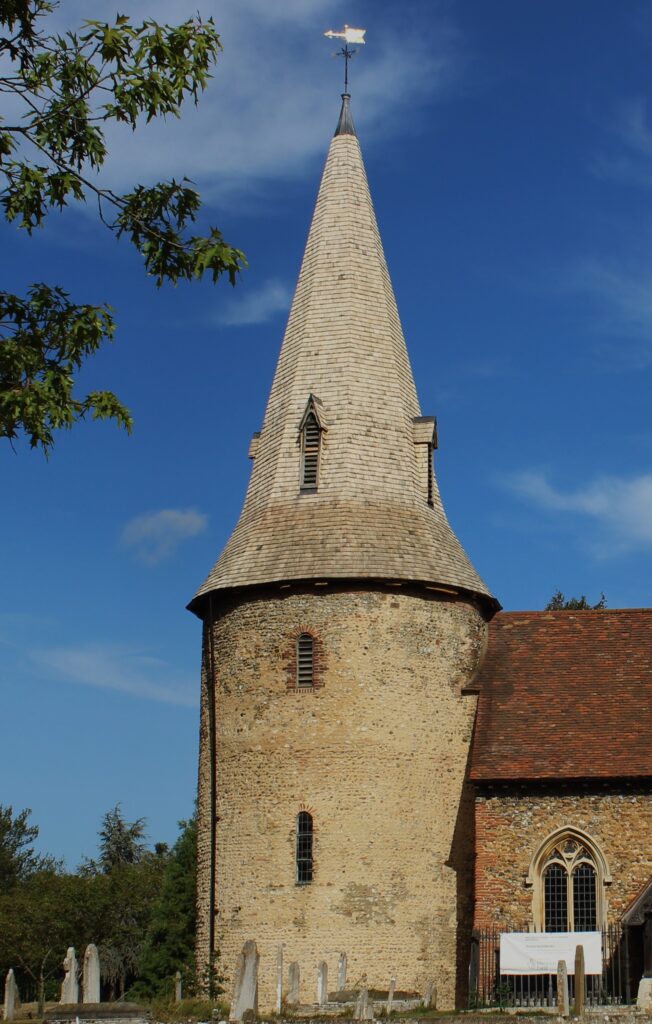
The earliest record of bells is as early as 1482 when Andrew Gyne left money for a passing bell. This was probably installed in the new spire in the position shown in this drawing from Twenty-two of the churches of Essex architecturally described and illustrated (1856) by George Buckler.

Records suggest that there were 3 bells in the spire, but one was smashed when it fell to the floor early in the 19th century. The present peal of six bells is made up of two recast old bells, one inscribed “John Dier made me 1580” and the other “Miles Graye made me 1613”, plus four new bells. John Dier seems to have been an itinerant bell founder, but Miles Graye made his bells in a foundry at Colchester.
The new bells were all cast by John Warner of London in 1874/75. The peal was presented to the Church by H. C. Wells of Broomfield Lodge, a churchwarden from 1864 to 1908. There is an inscription on the treble bell which reads:-
THIS PEAL OF BELLS
WAS PRESENTED
TO THE PARISH OF BROOMFIELD
BY H C WELLS
OF BROOMFIELD LODGE
1874 & 5
Stresses and Strains
This new peal of six bells was originally mounted in a timber frame on two timber beams and positioned on top of the masonry tower, as were the original three bells. Correspondence from Wykeham Chancellor, the Diocesan Surveyor, to the Vicar and Church Wardens in 1911, reveals that there were cracks in the masonry of the Tower and he warned against the ringing of the bells. These cracks were not evident in 1867-8 when Wykeham Chancellor’s father had carried out extensive repairs and alterations to the Church. The opinion was that this was recent and caused by the doubling of the number of bells in 1874-5, with the whole of the weight then resting on top of the walls. The cracks extended down through the walls to the window openings. It was considered that the stresses and strains on the Tower from the ringing of the bells must have been very great and far in excess of what would be the case if the frame was situated at a lower level. At that time it was reported by one source that the bell framework was of oak and very massive but by another source, very light, weak, badly constructed and becoming worse for wear. Whether this difference of opinion is due to these sources referring to either the bell frame or the supports is not clear. Either way, there was a need for repairs.
The solution adopted was to lower the bells to the first floor in the Tower and to inject cement in the cracks and strengthen with iron cramps. It would have been difficult to accommodate the existing timber bell frame at the lower level, so the bells were mounted in a cast iron frame manufactured by Carrs of Smethwick and supported by two steel joists manufactured by Dorman Long, Middlesborough. These are positioned north to south in the Tower. The top windows in the Tower were replaced with oak louvres.
The Positions of the Bells
Thus the bells were eventually rehung, in 1911-12, having been taken down some time previously because of the cracking in the tower. A special service of dedication was held on Friday evening 17th November 1911 for the rededication of the Bells. The Vicar, Revd Charles Edmund preached the sermon and gave dedicatory prayers after which a short peal was rung by the bell ringers.
But is that the whole story? In his letter to the Vicar and Church Wardens in February 1911, Wykeham Chancellor wrote that he was disposed to think that the present position of the bells, i.e. supported on top of the masonry tower wall, was not their original position, but that formerly the bells were at the level of the floor immediately beneath the bell frame. Was this the floor that is currently in place beneath the bell frame today? Were the bells mounted within the Tower prior to the erection of the spire in the late 15th century subsequently moved up into the Spire when it was built, in order to improve sound emission, as suggested by Chancellor?
Additionally we know that John Dier made one of the original bells in 1580 but we don’t know when the 3rd bell, which fell to the floor, was made. Did it pre-date 1580 and was this the passing bell referred to 1482, when Andrew Gyne left money for it? We assume that it was installed in the new spire.
The Wheel and Whole Circle

George Buckler’s diagram shows a large wheel (shown edge-on, in red) next to the bell. This was to enable ‘whole-circle’ ringing, a technique developed in the 18th and 19th centuries. The fifty year period between 1775 and 1825 was the most active and saw the emergence of local bands. Whole-circle ringing is practiced today, including here at St Mary’s. The wheel enables the bells to be swung through 3600. This technique gives control over the striking and enables call changes and methods to be rung. The technique was probably developed in the early days of change ringing. Call change ringing requires one ringer to give commands to change the order of the bells, as distinct from method ringing, where the ringers memorise the course of bells as part of a continuous pattern. Buckler’s 1856 diagram suggests that whole-circle was being practiced in Broomfield by that time.
Adding to the puzzle of the history of bells in StMary’s, Buckler’s diagram shows just one bell. If the drawing was produced in 1856 for George Buckler’s book, then where are the bells made by John Dier in 1580 and Miles Graye in 1613? The presence of the wheel on the right of the bell in the drawing suggests whole circle ringing, so one would expect the other bells to be in place – unless the drawing itself predates 1580.
Further Renewals and Repairs
The bells were again re-hung by two local ringers in 1938, using Hoffman ball-bearings from Chelmsford. In more recent years several tasks have had to be undertaken to keep the bells ringing out. In the late 1980s it was noted that the fixing of one of the steel joists was loose in the Tower Wall. This was allowing the frame to move during ringing. It was repaired by Whitechapel Bell Foundry and the works included steel bracing between the joists. The bearings were repaired and the ringers, helped by other church members and the local Scout Group, painted the frame and the timber work early in 1991. The total cost of all this work was around £4,500.
In 1993 new bell ropes were installed. Manufactured by John Pritchard (Ropes) Ltd. of Loughborough, these are 60ft long, made of pre-stretched terylene with natural flax yarn bottom ends with wool sallies.The cost of nearly £900 was met by a bequest from the family of RAF pilot Flt Lt Stan Bowles, who was killed in an RAF Tornado in the North Sea off Hull in August 1990. He was the son-in-law of Reg Morris, a Reader at the church. The first service with the new ropes was on the morning of 30 January 1994. During the service the Vicar, Rev. David Ritson, dedicated the ropes and the ringers responded with a short ring of several rounds. Ringers present were Peter Baker, Ian Hughes, Joy Ely, Andrew Mussell, Brian Warboys and Chris and David Marcus.The dedication coincided with the January Fifth Sunday Special service which looked back to 30 January 1649 when King Charles 1 was executed. Members of the Sealed Knot Society attended the service and an excellent cameo sketch was enacted by Mavis Tebby, Cyril Howard, Eric Rowley and the Vicar.
In November 2009 the clapper bearings on Bells 1 to 4 were found to have disintegrated. The clappers were removed and taken to the Whitechapel Bell Foundry for repair. The four clapper balls were well flatted and were therefore heated and twisted upon their stems to present unworn sections to impact the bells. The bearing pear-shaped tops were filled with resin into which was fitted a Tufnol bearing, sized to suit the existing hinge pin.

The repaired clappers and staples were re-installed in the Tower in time for the Christmas ringing. This work was carried out by the Whitechapel Bell Foundry at a cost of about £700. In 2016 further maintenance work was required. The bell wheel on No 2 bell was found to be loose and required the fixing of bolts and brackets to fasten it to the headstock. This work was again carried out by Whitechapel Bell Foundry at a cost of £1000.

The bells from above. The top of the masonry wall can be seen together with the base of the timber spire.
The round tower has a long draft – the bell chamber is high above the ground-level ringing floor. The sound of the bells down at ground floor was nevertheless very loud, due in part to the round tower wall; in 2000 a local firm, F.J. French, was commissioned at a cost of about £500 to install a double door and screen at the entrance to the bell chamber above the ringing floor. This diminished the sound at ground floor level.
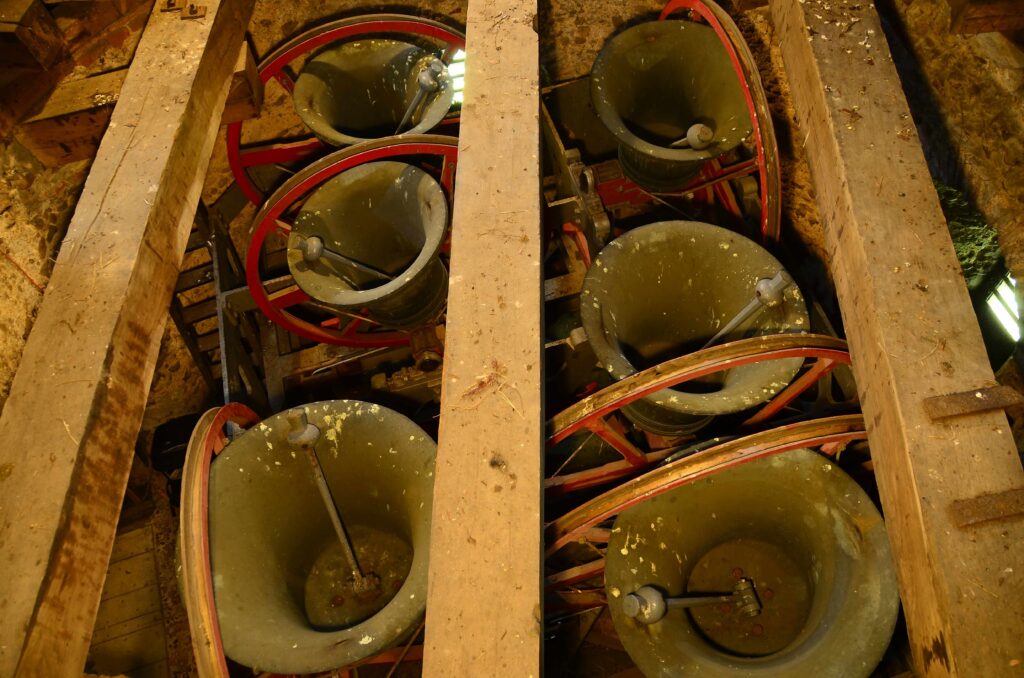
The bells in ‘up’ position.
Regular Ringing and Special Days
We have an active band of ringers who ring every Sunday for the morning service and also for weddings. Practice night is Wednesday every week when new ringers are trained and older hands practice new methods.

The clapper fully muffled, i.e. a leather muffle on both sides of the clapper, for the funeral of the late Queen Elizabeth II.
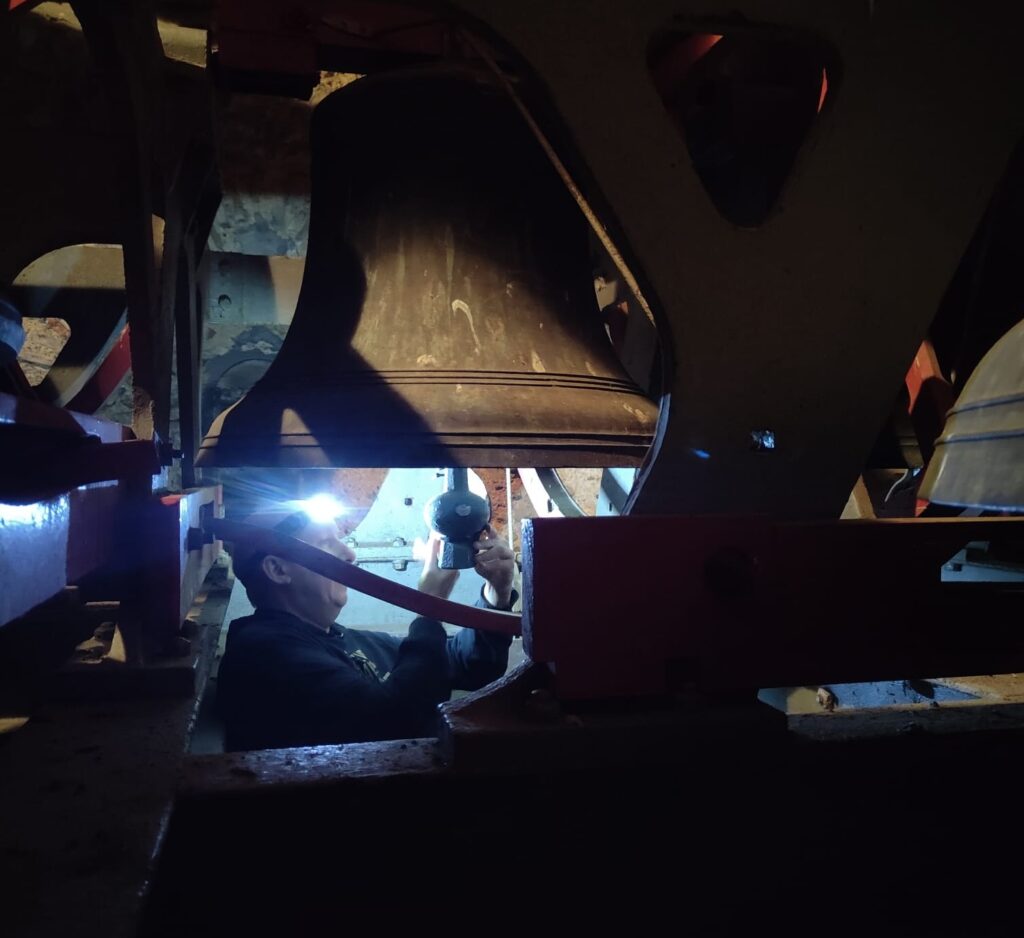
The Bell Captain fits a muffle to one of the clappers.
Just one muffle is used when the bells are rung ‘half muffled’ for the Remembrance service in November. New Muffles for the bells were purchased in December 1994 with assistance from the Stan Bowles’ fund mentioned above.
The bells are rung full, i.e. without muffles, for church services and at celebratory occasions such as the millennium and the accession and coronation of King Charles lll. The coronation ring was known as “Ring for the King” and was carried out by ringers all over the country. A badge was issued by the Essex Association of Change Ringers to all ringers who participated.

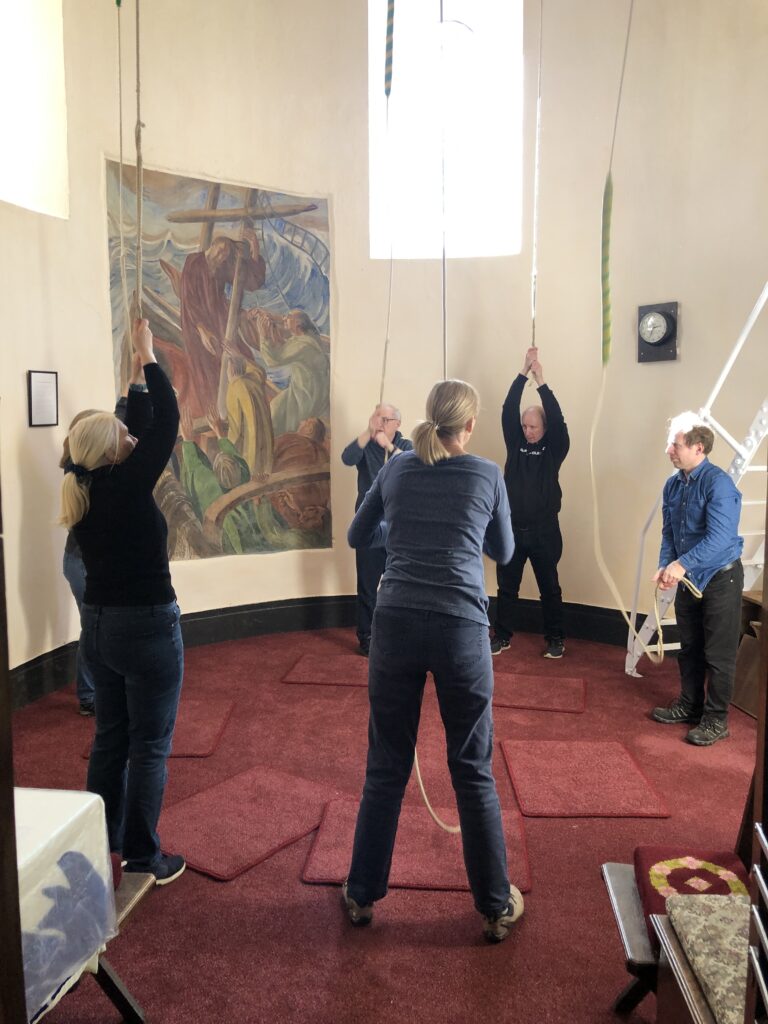
Ringing the Project Rutherford Celebration Service, March 2024
Other round tower churches in Essex:
St Mary’s Great Leighs, Holy Innocents Lamarsh, St Gregory and St George Pentlow, St.Peter and St Paul Little (Bardfield) Saling, and St Nicholas South Ockendon.
Most of the details on this page were drawn from an account compiled by David Marcus and Chris Marcus, Bell Captain.
